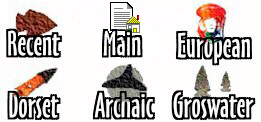![[Header]](habitation.jpg)
![[Header]](habitation.jpg)
Dorset Paleoeskimos, 2000-1300 B.P.
A Dorset Paleoeskimo House
Archeologists have been able to reconstruct a typical Dorset winter house at Philip's Garden. Dorset Paleoeskimos spent the late winter and early spring months in Port au Choix. The Dorset houses are more substantial than Groswater dwellings because they were re-used year after year. The houses, which ranged six to nine meters in diameter, were most likely occupied by an extended family or two separate families. Winter houses were recessed into the ground about 30 centimeters to prevent too much draft. The entrance faced the ocean and some houses included a draft resistant entrance that sloped downwards and then upwards, so that the person came up into the house. Wood or whale bone would have been used to frame the house. In this case post holes that angle inward indicate that whale ribs were used for framing purposes. The house would be covered and insulated with skins, layers of dirt, sod, or packed snow. A window made of something like walrus gut or thinned hide provided the only natural light.
The inside perimeter of the house had raised sitting and sleeping platforms that took advantage of the rising heat. They would be located at the rear of the house, or on each side. In the center of the house was a central paved area with a line of rocks or storage pits that served as the domestic area. It is here that food would be cooked and processed in large soapstone pots. Seal oil burning in soapstone pots was the main source of heat and light for these people. On each side of the central area were recessed living areas. The low head room was deliberate in an attempt to conserve heat.
Dorset Sites
There are two major sites at Port au Choix; the Phillip's Garden and Point Riche sites.
The Phillip's Garden site is located in a large grassy meadow, overlooking the ocean on the Point Riche Peninsula.
It is the largest known Dorset site in the Eastern Canadian Arctic. There are approximately 50 house depressions, four of which have been excavated by Dr. P. Renouf of Memorial University of Newfoundland (1984-1992); 20 were either fully excavated or partially tested by Dr. Elmer Harp of Dartmouth College, Hanover, New Hampshire (1949-1963). Phillip's Garden would have been an excellent launching area for any boats used in the spring seal hunt. This site appears to have been occupied off and on throughout the year by a constantly fluctuating number of people. Its more organized use of space suggests a greater permanence of settlement. The Dorset may have used this site to congregate (100 or more people) every year or two for social and ceremonial activities. If this is the case, there should be a communal house which, as of yet, has not been found.
The Point Riche site is similar to Phillip's Garden, but smaller. At least 19 house depressions can be found spread out on either side of a beach ridge.
Evidence of summer structures suggests that this site may have been occupied during the summer season by the people living at nearby Phillip's Garden. The ever-present wind here would eliminate any fly problem that would have plagued Phillip's Garden during this time of year.
Links to other
aspects of the Dorsets:
Settlement Areas
